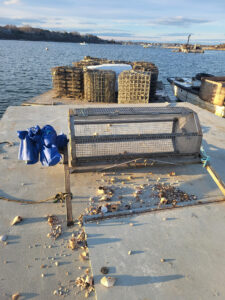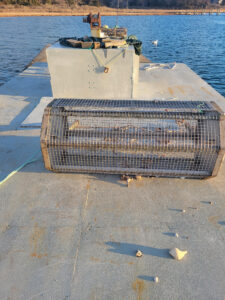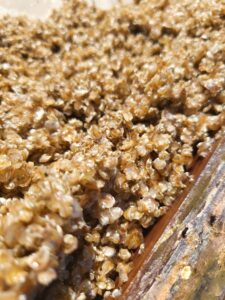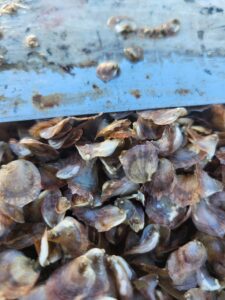Progress report for FNE24-097
Project Information
The objective of this project is to find the optimal tumbling
schedule to achieve well-shaped, petite oysters. The amount of
labor and equipment time will be weighed against size, shape and
meat quality improvements, across treatments and compared to
controls.
As many new oyster farms are started each year in the Northeast, the market competition increases. Many farms which have been in operation for decades, are challenged to keep up with market and consumer trends. On Martha’s Vineyard, a dozen oyster farms have been operating successfully in Katama Bay in Edgartown, for nearly 30 years. Katama Bay provides moderately high salinity water which is rich in phytoplankton food and favorable water temperatures. Farms in Katama Bay are able to achieve market size of 3”+ in about 18 months to 24 months. This has led to great success for most of the growers. However, more recently, many consumers prefer a “petite” oyster, or one that is closer to 2.5 inches. Growers in Katama struggle to produce a well-cupped, petite oyster because they grow so fast. The inability to produce a specific product is creating instability in some of the farms, as other farms in other growing areas, are in fact able to achieve a well-developed, smaller product. In order to maintain competitiveness, farms in Katama Bay and other highly productive growing areas, will need to adapt and create new methods for different results.
We propose a series of experiments to help growers in a similar position control the size and shape of the oyster they grow, through handling and tumbling. It is well-established that tumbling oysters, which chips away the thin, sharp new growth of an oyster, encourages the oyster to grow deeper and wider, instead of longer. Currently, the custom of most Katama Bay farms is to tumble the oysters just once before market, to round off the sharp growing edge. Additional tumbling sessions will cost labor and equipment time, and there for determining the optimal input needed for the desired output, is critical to the sustainability of the businesses.
Cooperators
- - Technical Advisor
Research
Starting in March of this year i began modifications to the oyster tumbler. The goal was to use mesh suitable for smaller oysters. I succeeded in modifying the mesh and works beautifully for our experiment at this time.
At the end of May every year we purchase oyster seed at 1.5 mm for our whole year's operation. This process t akes only a few hours. I carried out this task and the oyster seed were on their way. I attached some pictures.
In October we put aside our experimental cages and aquaculture bags for experimentation and labeled them accordingly. T1/T2/T3 (T stands for treatment). We then tumbled T2 and T3 and tucked them away to grow till about December by that time they will lay dormant till a few weeks before our next experiment In June. The idea is to tumble off a bit of shell then the oyster instinctively grows back stronger and rounder as this is something I have observed over the years of oyster farming.
So far I have set up the experiment and am excitedly waiting for the weather to warm up so that we can continue and get some results. I have modified the tumbler to handle the size of the oyster seed.
I sought out to improve the tumbler to handle the size oyster seed for the experiment. Additionally I sought out to receive the oyster seed and grow them to the point that the experiment can be conducted. Finally I sought to set up the experiment by labeling aquaculture bags with the experimental oysters and putting them away for winter. I succeeded in completing all of these tasks.
Education & outreach activities and participation summary
Participation summary:
I plan to post on social media about this project. littleminnowoyster on instagram.
Learning Outcomes
I estimate that oyster farmers who deal with very nutrient rich waters will be interested in the experiment. The oysters grow so fast when the water is rich in nutrients that they often times grow in an elongated shape which is not as desirable in a restaurant or market setting. I will be exited to post my findings.



